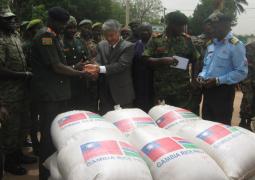World
AIDS Day takes place every year worldwide also in the Gambia 1st December.
Prevention,
Risk factors, transmission, Diagnose, Treatments
World
AIDS Day has taken place on December 1st every year since 1988.
It
provides an opportunity to draw attention to the HIV epidemic around the world.
Many people choose to organise an event on or around December 1st, to raise awareness
of HIV, to remember loved ones who have died, to show solidarity with people
living with HIV, to celebrate survival and health, and to raise money for HIV
and related causes.
For
many people the day is associated with the red ribbon, an instantly recognisable
symbol. Wearing a red ribbon is a simple way to show your support, and there
are also many other ways in which you can get involved.
Key facts
•
HIV is one of the world’s leading infectious killers, claiming more than 25
million lives over the past three decades.
•
There were approximately 34.2 million people living with HIV in 2011.
• HIV
infection can be diagnosed through blood tests detecting presence or absence of
antibodies and antigens.
Scope
HIV
is one of the world’s leading infectious killers, claiming more than 25 million
lives over the last 30 years. In 2011, there were approximately 34.2 million
people living with HIV. Over 60% of people living with HIV are in sub-Saharan
Africa.
Signs
and symptoms
The
symptoms of HIV vary depending on the stage of infection. Though people living
with HIV tend to be most infectious in the first few months, many are unaware
of their status until later stages. The first few weeks after initial
infection, individuals may experience no symptoms or a flu-like illness
including fever, headache, rash or sore throat.
As
the infection progressively weakens the person’s immune system, the individual
can develop other signs and symptoms such as swollen lymph nodes, weight loss,
fever, diarrhoea and cough. Without treatment, they could also develop severe
illnesses such as tuberculosis, meningitis, and cancers among others.
Transmission
HIV
can be transmitted via unprotected and close contact with a variety of body
fluids of infected individuals, such as blood, breast milk, semen and vaginal
secretions.
Individuals
cannot become infected through ordinary day-to-day contact such as kissing,
hugging, shaking hands, or sharing personal objects, food or water.
Examples
of HIV transmission routes include:
• Unprotected
sex with an HIV- infected partner;
• Mother-to-child
transmission during pregnancy, childbirth, or breastfeeding;
• Transfusion
with HIV-infected blood products;
• Sharing
of contaminated injection equipment, tattooing, skin-piercing tools and
surgical equipment.
Risk
factors
Behaviors
and conditions that put individuals at greater risk of contracting HIV include:
•
having another sexually transmitted infection such as syphilis, herpes,
Chlamydia, gonorrhea, and bacterial;
•
sharing contaminated needles, syringes and other infecting equipment and drug
solutions for injecting drug use;
•
receiving unsafe injections, blood transfusions, medical procedures that
involve unsterile cutting or piercing;
•
Experiencing accidental needle stick injuries, including among health workers.
Diagnosis
An
HIV test reveals infection status by detecting the presence or absence of
antibodies to HIV in the blood. Antibodies are produced by individuals’ immune
systems to fight off foreign pathogens. Most people have a “window period” of 3
to 12 weeks during which antibodies to HIV are still being produced and are not
yet detectable. This early period of infection represents the time of greatest
interactivity but transmission can occur during all stages of the infection.
Retesting should be done after three months to confirm test results once
sufficient time has passed for antibody production in infected individuals.
People
must agree to be tested for HIV and appropriate counselling should be provided.
HIV test results should be kept confidential, and everyone should receive
post-test counselling and follow-up care, treatment and prevention measures as
appropriate.
Prevention
Individuals
can reduce the risk of HIV infection by limiting exposure to risk factors. Key
approaches for HIV prevention include:
Condom
use
Correct
and consistent use of male and female condoms can protect against the spread of
sexually transmitted infections, including HIV. Evidence shows that male latex
condoms have an 85% or greater protective effect against the sexual
transmission of HIV and other sexually transmitted infections (STIs).
Testing
and counselling for HIV and STIs
Testing
for HIV and other STIs is strongly advised for all people exposed to any of the
risk factors so that they can learn of their own infection status and access
necessary prevention and
The
transmission
HIV
from an HIV-positive mother to her child during pregnancy, labour, delivery or
breastfeeding is called vertical or mother-to-child transmission (MTCT). In the
absence of any interventions transmission rates are between 15-45%. MTCT male
circumcision when safely provided by well-trained health professionals reduces
the risk of heterosexually acquired HIV infection in men by approximately 60%.
This is a key intervention in generalized epidemics with high HIV prevalence
and low male circumcision rates.
Elimination
of mother-to-child transmission of Han be fully prevented if both the mother
and the child are provided with antiretroviral drugs throughout the stages when
infection could occur.
Harm
reduction for injecting drug users
People
who inject drugs can take precautions against becoming infected with HIV by
using sterile injecting equipment, including needles and syringes, for each
injection. A comprehensive package of HIV prevention and treatment,
substitution therapy for drug users includes drug dependence treatment, HIV
testing and counselling, HIV treatment and care, and access to condoms and
management of STIs, tuberculosis and viral hepatitis.
Treatment
services without delay.
WHO
response
Since
the beginning of the epidemic, WHO has led the global health sector response to
HIV. As a co-sponsor of the Joint United Nations Programme on AIDS (UNAIDS),
WHO takes the lead on the priority areas of HIV treatment and care, and
HIV/tuberculosis co-infection, and jointly coordinates with UNICEF the work on
prevention of mother-to-child transmission of HIV.
This
date concerns all of us, not only because we are all possible subject to risky
behaviour, but also because we can all contribute to greater awareness of this
problem, as well as we can improve the conditions for infected and affected
persons.
The symbol of the fight against HIV/AIDS is
red ribbon, which has become recognized worldwide as a sign of solidarity with
infected and affected people.
HIV is abbreviation for „human
immunodeficiency virus“, which affects human immune system. HIV virus affects
only humans and is a precondition to get AIDS. This disease is contagious and
incurable.
Since
the beginning of epidemic, almost 78 million people were infected by HIV, and
it caused death of almost 34 million people. World Health Organization (WHO)
and Joint United Nations Program on HIV/AIDS (UNAIDS) estimate that in this
moment almost 36.9 million (34.3-41.4 million) people are HIV positive. Yearly,
over 2 million people get infected, and more than 1 million dies due to the HIV
related causes. It is estimated that more than 0.8 % of adults, age 15 to 49,
live with HIV, although this numbers significantly differ in different
countries and regions.
Today,
people who are HIV positive, thanks to medication, can live relatively normaly.
According to UN data, in the end of 2012., 35,3 million persons were living
with HIV, which is 18% more than in 2001.
Virus
is most commonly transmitted by sexual intercourse and less often by infected
blood, from mother to child during pregnancy, birth or breast-feeding. Virus
cannot be transmitted by usual social encounters or by animals.
World
AIDS Day is marked every year on December 1. Worldwide, in order to raise
awareness of epidemic, encourage progress in prevention, treatment and care of
HIV/AIDS, and express solidarity and support for people affected by this
disease. In period from 2011-2015, theme of world AIDS day was focused on
improvement and strengthening of public health programs and prevention and
stigmatization of HIV/AIDS as a global response on epidemic, with the moto:
„Getting to zero: zero new HIV infections. Zero discrimination. Zero AIDS
related deaths.“
In
Bosnia and Herzegovina, first case of HIV positive was recorded in 1986, and by
the year of 2015, there were 287 registered cases. In 2015., there were 13 new
HIV infections (FBiH 10, RS 3), of which 6 had AIDS (FBiH 5, RS 1). In last
five years, Bosnia and Herzegovina registers about 20-25 newly infected persons
per year.
According
to data from the year of 2013, there were 28 HIV positive persons in Canton
Tuzla, 12 of which had AIDS. During 2013, 2 newly infected persons were
registered, 11 patients were receiving therapeutic treatment, and 8 more were
under active supervision, because infection was not in stadium that requires
treatment. During the same year, 7 deaths caused by AIDS were recorded
HOW
CAN YOU SUPPORT WORLD AIDS DAY
By raising the awareness of people about
HIV/AIDS in your community.
By
wearing red ribbon and suggesting others to do the same.
By
protecting yourself – this is the primary and most important way of stopping
AIDS spread.
If
you think there is a reason – get tested for HIV.
For further information call on Government
National HIV/AIDS Agency (NAS), every government hospital EFSTH and clinics,
MRC and number of NGO and private Clinics, email azadehhassan@yahoo.co.uk, text
to 00220 7774469/3774469.
Author DR AZADEH Senior Lecturer at the University of the Gambia Senior Consultant in Obstetrics and Gynaecology. Clinical Director Medicare Health Services



